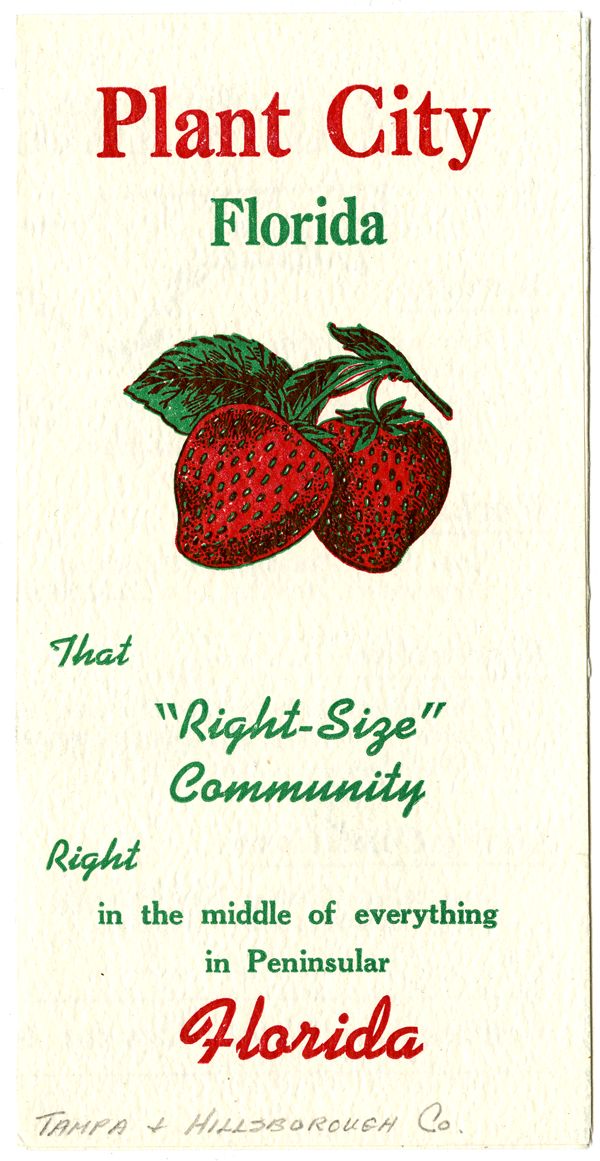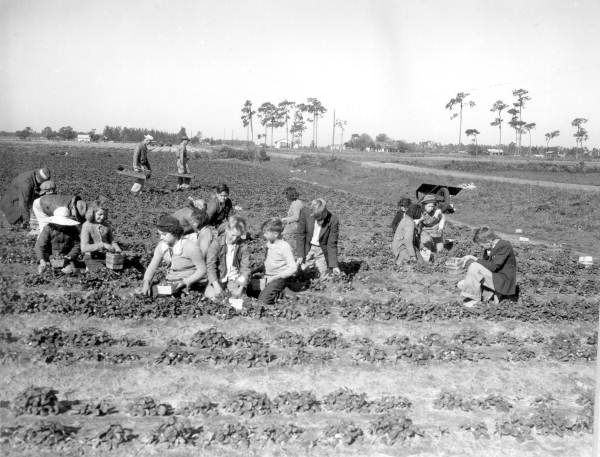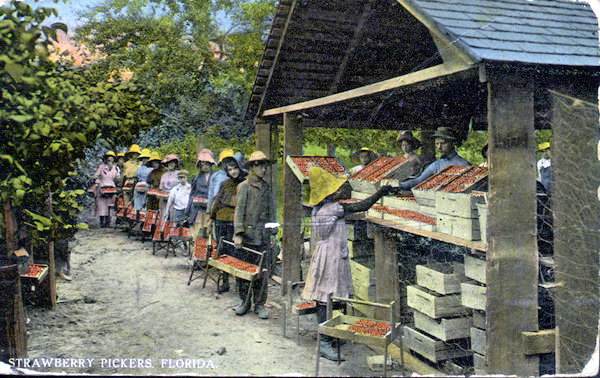Description of previous item
Description of next item
Strawberry Schools
Published January 1, 2016 by Florida Memory
Remember those late spring days back in grade school when all you could think about was the approach of summer vacation? Depending on your age and your preferences, you might have spent the time off swimming, taking family trips, or earning a little spending money at a summer job – anything but sitting still in a classroom.
There was a time, however, when some Florida students took their vacation much earlier in the year, from January through March. A number of counties in Central and South Florida mandated this to accommodate the harvest schedules for winter fruits and vegetables, which provided a living for small family farms. Strawberries were the main Florida crop requiring this arrangement. As a result, schools that operated on the modified April to December calendar were called “strawberry schools.”
Strawberries have been cultivated in Florida since the late 1800s. They have been grown in nearly every county in the state at one time or another, but large-scale sustained strawberry farming has mainly been centered in Hillsborough, Polk, Hardee, Bradford, Union, and Orange counties. These days, commercial strawberry farming is largely confined to large-scale operations with hundreds of acres under cultivation. Up until about the 1950s, however, family farms dominated the industry. In some places, strawberry farming came to define whole communities. Plant City, for example, has long been known as the “Winter Strawberry Capital of the World,” and strawberries have been a key theme in the town’s self-promotion.
Florida strawberries generally become ready to harvest between late December and March, right in the middle of the traditional spring session of the public schools. Farm families depending on the strawberry harvest for their livelihood often enlisted their children’s help tending and picking the berries. Gathering the fruit was only one part of the process; one woman remembered children being responsible for watering the rows of tender plants by hand and covering them with Spanish moss when the weather turned cold.
Strawberry farmers valued the labor their children provided at harvest time, but they also recognized the importance of their education. Some communities decided to have the best of both worlds by rearranging the school year. This was no new invention; the very idea of summer vacation was originally devised to allow farm children to help their families during the busy summer months. Plus, plenty of other states had similar systems to allow schoolchildren to help out at harvest time. There have at various times been “potato schools” in Connecticut, “apple schools” in New York, “tomato schools” in Ohio, and so on. What Central Florida needed was a “strawberry school” that would allow the students’ off-time to coincide with the strawberry harvest January through March.

Excerpt from the minutes of the Florida Board of Education, July 30, 1942 – volume 6, page 286, Series 252, State Archives of Florida.
And that is exactly what happened in many cases. In earlier years, counties would adjust the school year as needed for their particular harvest season. Once state education authorities began regulating the length and structure of the school calendar, local districts had to request permission to operate on a special schedule. Frequently, only some of the schools in a district would operate on the “summer” or “strawberry” system, while the rest of the county would use the more familiar “winter” system. In at least one case in Polk County, a school remained opened year-round and parents had the opportunity to choose which months their children would attend classes. A similar system was attempted for a few years in the early 1940s in Wimauma in Hillsborough County.
If you’re “warm-natured,” taking your vacation in the winter-time might not sound like such a bad idea, especially if you had to spend some portion of it walking up and down the rows of a field picking fruit at ankle level. The system had its problems, as veteran strawberry scholars have explained when asked about their experiences. Former Hillsborough County teacher Myrtis Hawthorne once told Tampa Tribune writer Leland Hawes that she remembered the gnats being so bad in her classroom that she often put a small dab of kerosene on her students’ faces to keep them away. The heat left her little choice but to keep the windows open, and so the gnats simply became part of the experience.
The strawberry school system was a boon for farmers, but several factors combined to bring it to an end in the years following World War II. Migrant workers had become a crucial part of the agricultural labor force during the wartime emergency, and in the postwar years they preferred to be able to move northward in the summer months as crops became ready for harvest. Also, improved roads and increased automobile ownership helped popularize the concept of the family vacation, which many families preferred to take in the summer.
The educational quality of strawberry schools also came into question during this period. In 1946, Tampa Tribune reporter J.A. “Jock” Murray began writing a series of articles criticizing the system as exploitative and academically deficient. Murray’s efforts helped pave the way for Florida’s landmark Minimum Foundation education law of 1947, but the school term remained a local option issue. The tide was turning, however, and in 1956 the Hillsborough County School Board abolished the strawberry school calendar for all of its schools. The remaining strawberry schools in surrounding counties followed suit soon afterward.
Strawberry farming is still a major winter industry in Central Florida, but these days children spend much more time eating the berries than picking them. Plant City still holds an annual Strawberry Festival that brings in thousands of visitors. This year’s event is coming up soon, by the way – the festival runs March 3-13, 2016. Now that you have a bit of local strawberry history under your belt, you’re all set to give it a try.
If you were a student again, would you choose a three-month winter vacation or a three-month summer vacation?
Cite This Article
Chicago Manual of Style
(17th Edition)Florida Memory. "Strawberry Schools." Floridiana, 2016. https://www.floridamemory.com/items/show/321965.
MLA
(9th Edition)Florida Memory. "Strawberry Schools." Floridiana, 2016, https://www.floridamemory.com/items/show/321965. Accessed February 26, 2025.
APA
(7th Edition)Florida Memory. (2016, January 1). Strawberry Schools. Floridiana. Retrieved from https://www.floridamemory.com/items/show/321965

 Listen: The Bluegrass & Old-Time Program
Listen: The Bluegrass & Old-Time Program



